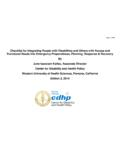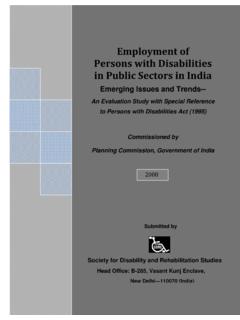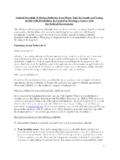Transcription of Inclusion of People with Disabilities in Zambia
1 Inclusion of People with Disabilities in ZambiaWomen and men with Disabilities can and want to be productive members of society. In both developed and developing countries, promoting more inclusive societies and employment opportunities for People with Disabilities requires improved access to basic education, vocational training relevant to labour market needs and jobs suited to their skills, interests and abilities, with adaptations as needed. Many societies are also recognizing the need to dismantle other barriers - making the physical environment more accessible, providing information in a variety of formats, and challenging attitudes and mistaken assumptions about People with situationAccording to the World Health Organization estimates, about 2 million women and men in Zambia , or 15 per cent of the population, have a disability1.
2 A higher percentage of People with Disabilities live in rural areas where access to basic services is limited. In 2005, the employment rate of persons with Disabilities was per cent of the population, compared to an employment rate of 58 per cent among persons without disabilities2. A 2000 Population and Housing Census, which collected data on disability, reported that a large percentage of People with Disabilities are self-employed workers, while very few are employers. The same Census also says that more than 80 per cent are employed in agriculture, making it by far the most common occupation3. As group, a majority of Zambians with Disabilities live in poverty and generally have unproportionally low literacy levels compared to persons without Disabilities .
3 Disabled persons often have to resort to street begging as a means of survival. 1 World Health Organization and World Bank: World Report on Disability 2011; World Bank 2012 (Zambian Population).2 SINTEF Living Conditions Report in Zambia , Zambia Central Statistical Office, 2000 Photo2 Governmental support for People with disabilitiesThe Government of Zambia has adopted a number of laws and policies pertaining to People with Disabilities , including their right to productive and decent work and to basic services, workers compensation, social security, and entrepreneurship development. The main ones are: The 1991 Zambian Constitution, amended in 1996, contains one provision on disability relating to just and equitable social benefits and amenities suitable to the needs of disabled People .
4 The country s Constitution is under review. The Technical Education, Vocational and Entrepreneurship Training (TEVET) Act, 1998, states that the special needs of People with Disabilities will be taken into consideration . The Workers Compensation Act (No. 10 of 1999), revises the law relating to the compensation of workers for Disabilities suffered or diseases contracted during the course of employment. The National Policy on Education, 1996, recognizes the right to education for each individual, regardless of personal circumstances or capacity. The Ministry of Education has overall responsibility for education, including special education. The National Employment and Labour Market Policy (NELP), 2005, shows the government s intentions to provide for improved care and support services to vulnerable groups, including People with Disabilities .
5 The National Youth Policy, 2006, aims at including disabled youth in mainstream programmes and projects targeting youth. The National Long-Term Vision 2030, articulates the country s development agenda for the next twenty-five years. One of the objectives is to make Zambia a middle-income country by 2030 in which all People will be provided with opportunities to improve their well-being. The Sixth National Development Plan (SNDP) 2011 to 2015, builds on the Fifth National Development Plan (FNDP) 2006-2010 and aims to attain the full participation, equality and empowerment of persons with Disabilities . It seeks to provide enhanced support to disabled persons through increased government spending on disability; develop inclusive mainstream policies; review existing pieces of legislation; and establish and/or strengthen institutions and systems that cater to People with Disabilities .
6 The Citizen Economic Empowerment Commission Act, 2008, aims at empowering People with Disabilities economically through start-up businesses that will employ others. The Persons with Disabilities Act, 2012, aims to domesticate and implement the UN Convention on the Rights of Persons with Disabilities while repealing the 1996 Persons with Disabilities Act. ILO Photo3 Key ministries and agencies for responsible for disability issues The Ministry of Community Development, Mother and Child Health (MCDMCH) is entrusted with formulating policy for People with Disabilities . The Zambia Agency for Persons with Disabilities (ZAPD) has the responsibility to coordinate the implementation of the National Policy on Disability and acts as an advisory body to the Ministry.
7 The Ministry Education, Science, Vocational Training and Early Education (MESVTEE) has responsibility for developing science and technology and for the provision of technical education and vocational training. The Technical Education, Vocational and Entrepreneurship Training Authority (TEVETA) has responsibility to improve technical education and vocational training, while linking them to the requirements of the employment international standards on disability and their status International Labour Organization (ILO) Convention Concerning Discrimination in Respect of Employment and Occupation, 1958, (No. 111). Status: ratified, October 23, 1979. ILO Convention Concerning Vocational Rehabilitation and Employment (Disabled Persons), 1983, (No.)
8 159). Status: ratified, January 5, 1989. United Nations Convention on the Rights of Persons with Disabilities (2006). Status: ratified, February 1, 2010. Optional Protocol signed September 29, 2008, not yet also works to implement the Action Plan established for the African Decade of Persons with Disabilities , extended to December of persons with disabilitiesAt the federal level, the Zambia Federation of Disability Organizations (ZAFOD) is an umbrella organization representing several disabled persons organizations. Its main activities include advocacy and awareness-raising. It also provides small loans to People with Disabilities and training in small-scale business management. The following DPO s are members of ZAFOD: - Zambia National Association of Disabled Women- Zambia National Association of the Deaf- Zambian National Association of the Hearing Impaired- Zambian National Association of the Partially Sighted- Zambian National Association of the Physically Handicapped- Zambian Association of Children and Adults with Learning Disabilities - Zambia Association of Parents of Children with Disabilities - Mental Health Users Network of Zambia (MHUNZA)Other significant organizations.
9 - Zambian National Federation of the Blind- Disacare Wheelchair Centre- Zambia National Library and Cultural Centre for the Blind- Zambia Association on the Employment for Persons with DisabilitiesILO Photo4 January 2013 The role of the ILOThe primary goal of the ILO today is to promote opportunities for everyone, including People with Disabilities , to obtain decent and productive work, based on the principles of freedom, equity, security and human dignity. The ILO works to achieve its goals of decent work for all through promoting labour standards, advocacy, knowledge building and technical cooperation services and partnerships, both within the ILO and externally. The Zambia Decent Work Country programme establishes the framework for delivery of ILO action in this country.
10 In Zambia , a current ILO technical cooperation project Promoting Rights and Opportunities for People with Disabilities in Employment through Legislation (PROPEL) has the following goals: Improved capacity of governments and social partners to address discrimination against persons with Disabilities and promote equality of opportunity in training and employment for men and women with Disabilities . Improved media capacity to report on the rights of persons with Disabilities and portray their working capacities. Improved employability of persons with Disabilities through access to skills development is being implemented by the Zambia National Project Coordinator, with support from the Regional Disability Advisor, Lusaka in consultation with the Disability Team at the ILO headquarters in way forward Productive and decent work enables People with Disabilities to realize their aspirations, improve their living conditions and participate more actively in society.

















